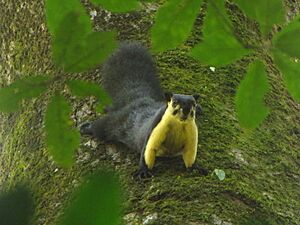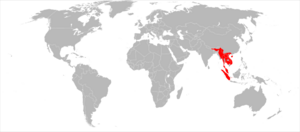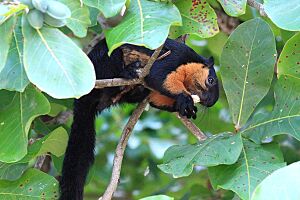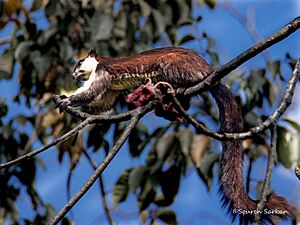Black giant squirrel facts for kids
Quick facts for kids Malayan black giant squirrel |
|
|---|---|
 |
|
 |
|
| Above in Khao Yai National Park, Thailand; below in Namdapha Tiger Reserve, India | |
| Conservation status | |
| Scientific classification | |
| Genus: |
Ratufa
|
| Species: |
bicolor
|
| Subspecies | |
|
|
 |
|
| Black giant squirrel range (erroneously missing Java and Bali) | |
| Synonyms | |
|
Tennentii, source: Layard, in Blyth, 1849 |
|
The Malayan black giant squirrel (Ratufa bicolor) is a very large tree squirrel. It belongs to the Sciuridae family. You can find it in the tropical forests of Indomalayan regions.
These squirrels live in many countries. Their home stretches from northern Bangladesh and northeastern India to Myanmar and southern China. They also live across mainland Southeast Asia, including Laos, Thailand, Western Malaysia, Cambodia, and Vietnam. You can also find them on some Indonesian islands like Bali, Java, and Sumatra.
Contents
What Does It Look Like?

The black giant squirrel is one of the biggest squirrels in the world! An adult squirrel usually weighs about 1 to 1.25 kilograms (2.2 to 2.75 pounds). From its nose to the start of its tail, it measures about 34 to 37 centimeters (13 to 14.5 inches). Its long tail adds another 41 to 42 centimeters (16 to 16.5 inches) to its length.
These squirrels usually have two distinct colors. Their body, tail, and back are very dark, often deep brown or jet-black. Their chin, neck, and belly are much lighter, usually yellowish or light beige. On islands like Sumatra, Java, and Bali, their dark fur might have lighter tips, making them look a bit brighter. Some squirrels on small islands near Myanmar have orange-red or yellow-red fur on their lighter parts.
Where Do They Live?
Malayan black giant squirrels live in many different bioregions, but they all have one thing in common: they are all forests! They can live from sea level up to mountains as high as 2,500 meters (8,200 feet).
Sadly, in recent years, their forest homes have been shrinking. People are building more homes, cutting down trees for wood, and using land for farming. This, along with some hunting, has caused their numbers to go down. In some places, laws or traditions help protect these squirrels from hunting.
In South Asia, these squirrels live in tropical and subtropical forests. These can be forests with pine trees or trees with wide leaves.
In Southeast Asia, they prefer tropical forests with evergreen trees (trees that stay green all year). They are rarely seen in pine forests there.
You might not see as many black giant squirrels in the rainforests of the Malay Peninsula and Indonesia. This is probably because other animals, like primates, also live there and compete for the same food in the treetops.
If you want to spot a black giant squirrel, good places to look include Kaziranga National Park in Assam, India. You can also find them in the lower parts of Neora Valley National Park, Kalimpong, India.
Scientists have found that rainfall and how land is used affect where these squirrels live. They can be found high up in the mountains, even above 1,500 meters (4,900 feet). Some studies suggest that by the year 2050, climate change could make it very hard for these squirrels to find suitable homes in India.
How Do They Behave?
Malayan black giant squirrels are active during the day (this is called diurnal). They mostly live in trees (this is called arboreal). However, sometimes they will come down to the ground to find food. These squirrels usually stay away from farms or towns. They prefer to live in the wild forest.
Their diet includes seeds, pine cones, fruits, and leaves. They usually live alone. A mother squirrel will have one or two babies at a time. She raises her young in a drey, which is like a nest. These nests are often built inside hollow spaces in trees.
Different Types of Squirrels
Scientists are still studying the Malayan black giant squirrel. They want to find out if what we call one species might actually be several very similar species.
There are ten known types, or subspecies, of the Malayan black giant squirrel. Each subspecies might have slight differences in appearance or where they live.



